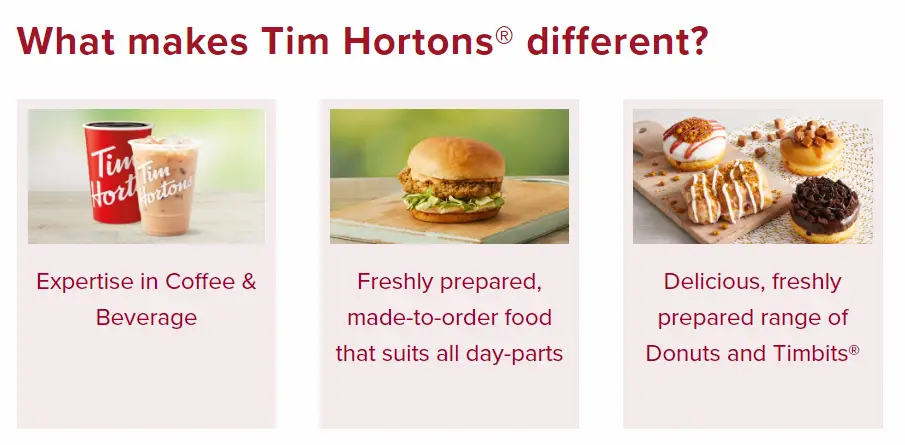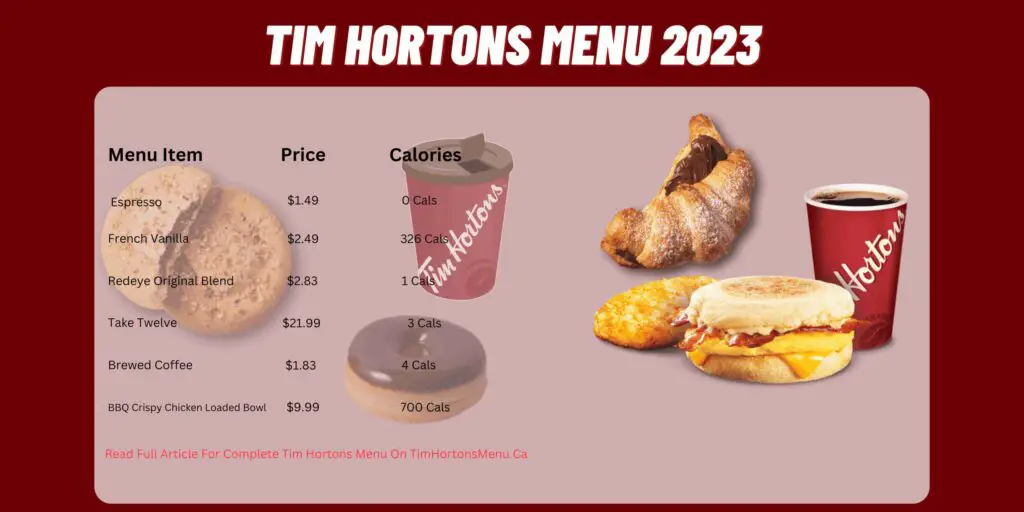Tim Hortons’ positioning in the quick service restaurant industry is centered around the quality and value pricing of the coffee, doughnuts, and other fast-food options available at its outlets.
The company has also positioned itself as a brand that is committed to fulfilling its corporate social responsibilities towards the people in its supply chain as well as the communities they serve.
This can be seen in various initiatives such as its employee compensation package, ethical sourcing of ingredients and items, and its outstanding contributions to the communities where it is found.
Tim Hortons is one of the most notable Canadian companies which was established in 1964 by Tim Horton and Jim Charade. Its first restaurant in Hamilton, Ontario was known as Tim Horton Donuts before it was later abbreviated to Tim Horton’s and eventually changed to Tim Hortons.
The name change was necessitated by the brand’s expansion of its menu to include other items such as coffee, baked goods, and other fast food options.
Since the company started out in Canada, Tim Hortons’ target market was initially Canadian but this customer base has since expanded to include several other consumer demographics.
Currently, in 2023, the brand has expanded to about 15 countries including the United States, China, Mexico, the United Kingdom, the Phillippines, and the United Arab Emirates.
As of September 30, 2023, the brand reported having 5,701 outlets which combined both company-owned and franchised restaurants. They also have plans of expanding operations in existing markets and opening new restaurants in additional countries.
In its almost sixty years of existence, Tim Hortons’ positioning, as well as its marketing strategies, have aided its successful operations, hence, in this article, we shall discuss the various strategies used by the company in maintaining its position in the quick service restaurant industry.
See also: Costco Positioning and Marketing Strategies
What is the positioning statement of Tim Hortons?
The positioning statement of Tim Hortons is captured in its vision, “To be the standard pioneer of everything we do.” This means that the company strives to be the best in the quick service industry.
The company’s mission statement, “Our driving mission is to produce our guests and communities with superior quality goods and services through leadership, creativity, and collaborations” also positively contributes to its positioning statement. It ensures that the brand strives towards ensuring that its menu meets and even exceeds consumer expectations.
See also: Subway Positioning and Marketing Strategies
Tim Hortons positioning strategy
- Freshly prepared food
- Value pricing
- Community beneficial initiatives
Tim Hortons’ positioning strategy is a well-curated marketing plan that is used by the brand to influence and determine its defining features in the minds of its customer base. This usually has an impact on consumer perception, the brand’s ability to attract and retain customers, and its overall position in the marketplace.
The brand positioning of Tim Hortons differentiates the company from other quick service restaurants that operate within the same locality. Thus, to ensure that its position as one of the leading quick-service restaurants in the industry is maintained, Tim Hortons employs the strategies that we shall discuss below:
Freshly prepared food
The main positioning strategy of Tim Hortons is being a brand that serves freshly prepared food. This is captured in its popular tagline, “Always Fresh. Always Tim Hortons.” The freshness of menu items appeals to a large consumer base especially those who are conscious of not eating stale food and those who have associated freshness with healthy eating.

In keeping up with this commitment to serving fresh menu items, the brand has a policy of serving coffee within twenty minutes of brewing. Apart from coffee, the brand also provides other freshly prepared items such as sandwiches, wraps, value snacks, and homemade soups.
These products are divided into different standardized menu offerings such as hot and cold beverages, baked goods, smoothies, sides, etc. It is also divided based on different meal times such as breakfast, lunch, and dinner. Hence, people are assured of getting a fresh meal from Tim Hortons at any time of the day since these restaurants generally operate 24/7.
Through the brand’s original menu items such as Double Double coffees and Timbits, Tim Hortons has captured a large consumer base, thereby making it a household name in Canada with about 80% of Canadians visiting the restaurant at least once a month.
Value pricing
The value pricing is another positioning tactic that Tim Hortons uses. This has been an effective strategy especially due to the unstable nature of the global economy and the drive of most individuals to gain the highest possible value on every dime they spend.
Value pricing is one of the pricing strategies that a brand can use. It entails pricing the brand’s products in such a way that the price corresponds with the perceived value of the product.
For instance, currently in 2023, a large cup of cappuccino at Tim Hortons case in the United States costs $4.95 while the same size of cappuccino costs $5.29 at McDonald’s. Although these prices are within a close range, the pricing difference of $0.34 presents Tim’s as offering a better value.
As such, this value pricing of menu items has positioned Tim Hortons as a brand that offers consumers better value for every dollar spent at its restaurants.
Community beneficial initiatives
- Tim Hortons Foundation Camps
- Smile cookie program
- Timbits Minor Sports Program
Being an active part of the community through several community-beneficial initiatives is one of the major positioning strategies that Tim Hortons has employed since its inception. In the words of the brand:
We have always had a deep connection to our communities and our guests from coast to coast. Our more than 1,500 restaurant owners are Canadians who live in communities across the country employing over 100,000 people. Our local Owners and their teams care deeply about the communities they serve. That’s why we provide over $60 million per year to organizations and communities throughout Canada. From signature programs like Timbits® Sports and the Tim Hortons Foundation Camps, we invest in community projects and initiatives big and small.
Tim Hortons
The company’s positioning as a community-based brand is also mirrored in its commercials which usually focus on the brand’s role in fostering friend and family togetherness through the various sporting activities that the brand supports.
Tim Hortons also offers seasonal sporting activities that attract a large crowd of people such as free skate days in winter and free swim days in summer.
These initiatives further brand awareness, retain existing customers, attract new ones, and aid the brand’s positioning by capturing the hearts of kids and teenagers who eventually grow up to become loyal customers of the brand.
Let us discuss some of the community-beneficial initiatives that Tim Hortons has used in its positioning.
Tim Hortons Foundation Camps
One of the community-beneficial initiatives that has become really popular is the Tim Hortons Foundation Camps. The company has a total of seven Tims Camps in Canada and the United States.
The camp offers three programs viz:
- Summer program
- School program
- Partnership
Tim Hortons Foundation Camps are curated for teenagers within the age range of 12 to 16 with programs aimed at social and emotional development and resiliency. It also serves as a platform for connecting teenagers with caring and supportive adult leaders as well as building peer friendships.
The initiative has its vision and mission statements as: “Through life-changing programs, help youth imagine a future without poverty” and “To help youth from underserved communities achieve their full potential” respectively.
Since this community initiative started in 1974, it has been a resounding success and recorded hosting thousands of teenagers annually. It has been additionally beneficial because it is totally free and parents need not worry about paying huge camping fees for their children.
The brand however has specific selection criteria which is used in selecting teenagers that can participate in the camping program because the camp focuses on helping children in disadvantaged circumstances discover the strengths within themselves.
From its inception through December 31, 2022, the Tim Hortons Foundation’s annual Camp Day has raised over C$237 million and has sent more than 300,000 youth to a multi-year camp-based program.
Smile cookie program
The Smile Cookie program is another community-beneficial fundraising initiative that Tim Hortons started in 1996. At the time, all funds raised from the sale of smile cookies in participating restaurants aside from tax were donated to the Hamilton Children’s Hospital in Ontario, Canada.
The expansion of Tim Hortons restaurants outside Canada also increased the organizations that benefit from the funds raised through the sale of smile cookies or smile cookie personality pins such as charities, hospitals, and community programs.

For this year 2023, the fundraising window was between the 1st to 7th of May. It also included a smile cookie decorating event which was held on 6th May. The funds raised were used to support 22 hospitals and charities across the United States and Canada including Dayton Children’s Hospital, Travis Mills Foundation, The Rainbow Connection, and Boys & Girls Club of Northern Chautauqua County.
Every year, different charities, hospitals, or community clubs get to benefit from this initiative with several individuals directly benefiting from the programs and activities that these organizations do in their host communities.
Since the first-ever Smile Cookie campaign in 1996, this community-beneficial program has raised more than C$92 million which has been donated to different organizations. Thus, Tim Hortons actively contributes to ensuring that it supports local charities so that its host communities can benefit.
Timbits Minor Sports Program
The Tim Hortons Timbits Minor Sports Program is an additional community-beneficial program that provides opportunities for children between the ages of 4 to 8. This provides an opportunity for kids to learn a new sport, play in a league, make new friends, and generally have a good time with other kids.
The company provides branded jerseys to Timbits players in various sporting activities including local soccer and hockey associations across Canada and the United States. Hence supporting thousands of children who are interested in sports annually.
In 2022, Tim Hortons supported over 375,000 boys and girls through Timbits Sports. The philosophy of the program is not based on winning or losing, but on learning a new sport, making new friends, and just being a kid.
See also: Chick Fil A Marketing Strategies and Marketing Mix
What strategy does Tim Hortons use?
Tim Hortons uses a combination of positioning strategies including freshly prepared menu items, value pricing, and community-beneficial initiatives such as Timbit sports and the Smile Cookie program.
Considering the large extent of the brand’s recognition as a provider of fresh coffee and other fast food products, its deeply ingrained Canadian cultural identity, and its involvement in various initiatives that benefit its hosting communities, Tim Horton’s has made good its positioning as a top contender in the quick service industry.
See also: Lululemon Marketing Strategies and Marketing Mix
Tim Hortons’ positioning using the marketing mix
- Product
- Price
- Place
- Promotion
The 4 components of the marketing mix are an integral part of the positioning strategy used by Tim Hortons in its effort to maintain its market share while attracting new customers. Over the years, the brand has used the marketing mix to expand its products, geographical locations (place), and customers through its promotion programs.
Product
Tim Hortons uses its products to position its restaurants as quick service outlets with a wide range of menu that serves a diverse consumer base including workers, children, travelers, students, and parents.
Although the brand’s menu typically comprises premium blend coffees, doughnuts, muffins, pastries, cookies, hot and cold specialty drinks, wraps, sandwiches, soups, and value snacks, some restaurants may offer additional menu options that appeal to consumers in its specific geographical region.
For instance, the Tim Hortons in India offer menu items such as Kaffir lime & strawberry cooler, loaded BBQ paneer rice bowl, and chicken seekh wrap.
By curating the brand’s product to have both a standardized menu as well as regional variations, Tim Hortons has positioned itself as a brand that offers consistent menu options across its global outlets as well as specifically curated menu items.
In this way, patrons who like the brand’s regular menu items such as the double double coffee and Timbits can enjoy these items at any Tim Hortons restaurant worldwide. On the other hand, new consumers in regions where the brand was previously unknown such as the Phillipines and Spain can attract locals by offering menu items that are familiar to the region.
An additional factor that aids Tim Hortons positioning through its products is its provision of fresh menu items such as freshly baked goods and fresh coffee. This strategy attracts consumers by assuring them of getting fresh products anytime they visit any of the brand’s restaurants.
Price
The pricing of a product is one of the great contributors to a brand’s success, consumer patronage, and positioning. Tim Hortons uses a combination of value and psychological pricing. These are common product pricing techniques in marketing aimed at attracting and retaining customers.
Value pricing ensures that the price of a product is in tandem with its perceived value while psychological pricing makes use of pricing ending in numbers such as 5 or 9 instead of 0.

An example of value pricing can be seen in how Tim Hortons prices its bacon, egg, and cheese when compared to its competitors in the market. One of the brand’s competitors, Subway, prices its bacon, egg, and cheese at $8.99 while the same costs $4.29 at Tim’s.
In the case of psychological pricing, for instance, instead of pricing a cup of brewed coffee at $2.00, the brand prices it at $1.95 or $1.99. This makes consumers view the product as better and cheaply priced when compared to the whole number pricing. Hence, it psychologically appeals to consumers better.
Tim Hortons’ use of value and psychological pricing strategies ensures that the company’s menu prices fall below the average price offered by other quick service restaurants such as McDonald’s, and Subway. Therefore, it positions Timmies as a brand that ensures its customers are well satisfied by offering an equal quality product at a lower price.
Additionally, the pricing appeals to a wide consumer demography including those who are price-conscious, seeking healthy options, or just in need of a quick meal. By attracting this large consumer base based on the price and quality offered, Tim Hortons is able to maximize company profits and maintain consumer loyalty.
Place
The place is a key means of positioning for Tim Hortons as it is the channel through which consumers get to purchase the brand’s products. Timmie’s restaurants are located in diverse places including high-brow neighborhoods, city centers, and streets.
Based on the brand’s third quarter 2023 report, the brand has 5,701 outlets which comprise both company-owned and franchised restaurants. These include several restaurant formats including stand-alone restaurants, small full-service restaurants, self-serve kiosks, and drive-thrus.
Tim Hortons also partners with other brands to operate co-branded outlets with products from both the brand and its partners sold at such stores. An example of such a partnership is that between the brand and ColdStone Creamery.
This diversity of restaurant locations and formats gives additional competitive advantages to Tim Hortons by expanding its reach and further strengthening its position in the industry.
Promotion
Tim Hortons uses a combination of marketing strategies that are aimed at effectively promoting the brand’s product to its target market. The promotion efforts include focusing on new menu items, breakfast deals, new store openings, consumer rewards, etc.
These promotions are carried out using both traditional and digital marketing platforms such as television, radio, social media, SMS, and email marketing. They also use event and sports sponsorship as another means of brand and product promotion.
Some common events that the brand has sponsored include the Brier, the Canadian Ringette Championships, and several other sporting and community events.
Tim’s also collaborates with renowned actors, musicians, athletes, and other celebrities who serve as influencers for its brand and products. Some celebrities who have worked with or endorsed the brand include Maitreyi Ramakrishnan, Sidney Crosby, Justin Bieber, Dan O’Toole, and Tristan Thompson.
The brand reports that it spends between 2 to 5% of gross sales fund all expenses related to brand and product promotion such as market research, production, advertising costs, sales promotions, social media campaigns, and technology initiatives.
Through brand and product promotion, Tim Hortons has increased its brand awareness, attracted new customers, and retained a large percentage of its repeat customers. This has consequently resulted in increased sales viz a viz higher profitability.
See also: Digital and Physical Marketing Examples and Differences
What is Tim Hortons unique selling proposition?
The unique selling proposition of Tim Hortons is providing fresh fast food items at competitive rates to consumers. The brand’s dedication to building long-lasting mutually beneficial relationships with its consumers and host communities is another unique selling proposition of the brand.
See also: Societal Marketing Definition and Examples
Conclusion
Several factors have contributed to Tim Hortons’ positioning as a top Canadian quick service restaurant such as its history and strong market share in the country. Its store designs and use of the maple leaf in its decorations further position it as a deeply Canadian brand.
The brand’s offering of fresh menu items, inexpensive pricing, and easily accessible locations across the globe has placed the brand as a global brand which has carved a niche for itself as one of the most committed brands when it comes to satisfying its customers and improving their communities.
Blessing's experience lies in business, finance, literature, and marketing. She enjoys writing or editing in these fields, reflecting her experiences and expertise in all the content that she writes.
